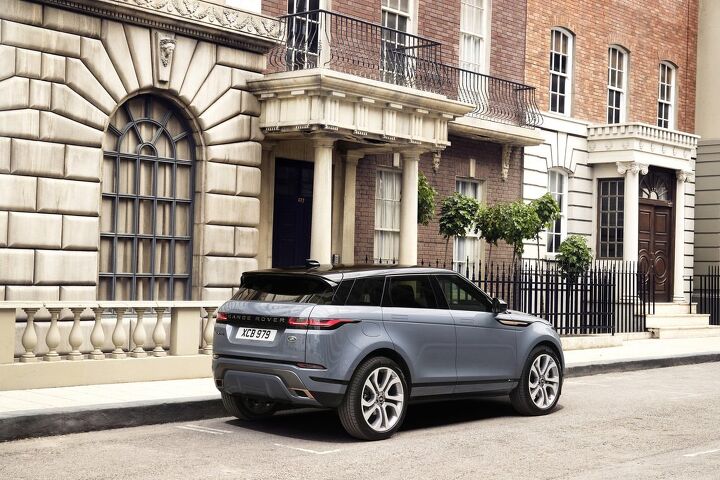Aiming Higher: 2020 Range Rover Evoque Ups the Class, Not the Size

During Jaguar Land Rover’s unveiling of the updated version of its smallest Range Rover model, the automaker made sure everyone knew the only carryover components from the not-fully-baked first-generation model were the door hinges. This is not your realtor’s Evoque, JLR assures us.
Revealed in its native UK, the second-gen Range Rover Evoque — arriving next year as a 2020 model — keeps the tidy footprint of its predecessor while boosting the model’s high-zoot trappings and technology. It’s more powerful, greener, and capable off-road than before, JLR claims, and there’s no longer even a whiff of Ford about the thing. Under that hood is an engine proudly flying the Union Jack.
There’s no mistaking it as an Evoque, either, though observers will no doubt notice a design that’s moved in the direction of the lengthier Velar. Still, the gripes hurled at the first-gen model, which first appeared in 2010, were not styling related. And there were many gripes hurled, no doubt about it.
With the 2020 model, JLR sought to correct past mistakes. Beneath the upcoming Evoque is a new platform — JLR’s Premium Transverse Architecture, which affords rear-seat passengers an extra eight-tenths of an inch of legroom via a mild wheelbase stretch. Keep in mind that it’s the same sized package as before, so miracles aren’t plentiful here. Improvements, yes. In addition to a body that’s 13 percent stiffer than before, cargo volume expands by 6 percent, to 21.5 cubic feet. Fold that rear bench down, and 50.5 cubes greet the proud Evoque owner.
Power-wise, the UK-market Evoque makes use of two Ingenium four-cylinder powerplants, each offered in three flavors. We’ll skip over the diesel offerings, focusing instead on the gas-powered motors most likely to see service on this side of the Atlantic. The 2.0-liter Ingenium range starts at 197 horsepower and 251 lb-ft of torque, moves up to 246 hp and 269 lb-ft, and tops out at 296 hp and 295 lb-ft. It’s the latter two engines we’ll be seeing here, if Jaguar’s U.S.-market XE powerplants tell us anything.
Joining these two engines is a 48-volt mild-hybrid system, which captures energy lost through braking and coasting and stores it in an underfloor battery pack. The juice returns to the drivetrain through a belt-integrated starter generator, providing a boost during acceleration and allowing the Evoque to shut down its internal combustion engine at speeds below 11 mph, though only if the brakes are being applied. In a year’s time, a three-cylinder plug-in hybrid should show its face.
All-wheel drive comes standard (UK drivers get a 2WD manual diesel), with multiple terrain modes to choose from, though JLR offers an Auto mode for owners who’d prefer the vehicle governs itself. Water fording, a chief concern for all Evoque owners, improves with this new model. You’ll now be able to tackle 23.6 inches of the wet stuff, up from 19.7 inches in the first-gen model. Should you be of the adventurous type, JLR’s ground view camera, which monitors the area ahead of and below the front bumper, might just prevent your oil pan from being carried away by a jutting slab of granite.
Inside and out, luxury cues abound. LED lighting fore and aft lends a contemporary premium feel, and flush door handles, while wholly unnecessary, nonetheless scream “I’ve paid for this — it’s worth it!” As you can see, the Evoque’s dash doesn’t lack padding, nor touchscreen acreage. The dual-screen setup is an optional feature, pairing two 10-inch surfaces in the center stack with a 12.3-inch digital gauge display.
Lastly, you’ll find both Apple CarPlay and Android Auto as standard kit on this vehicle, allowing the Evoque to offer the same level of connectivity as many generic compact sedans. What’ll a new Evoque set you back, you ask? The automaker isn’t telling, preferring to release its U.S. pricing at the 2019 Chicago Auto Show.
[Images: Jaguar Land Rover]

More by Steph Willems
Latest Car Reviews
Read moreLatest Product Reviews
Read moreRecent Comments
- Jalop1991 Our MaintenanceCosts has been a smug know-it-all.
- MaintenanceCosts If I were shopping in this segment it would be for one of two reasons, each of which would drive a specific answer.Door 1: I all of a sudden have both a megacommute and a big salary cut and need to absolutely minimize TCO. Answer: base Corolla Hybrid. (Although in this scenario the cheapest thing would probably be to keep our already-paid-for Bolt and somehow live with one car.)Door 2: I need to use my toy car to commute, because we move somewhere where I can't do it on the bike, and don't want to rely on an old BMW every morning or pay the ensuing maintenance costs™. Answer: Civic Si. (Although if this scenario really happened to me it would probably be an up-trimmed Civic Si, aka a base manual Acura Integra.)
- El scotto Mobile homes are built using a great deal of industrial grade glues. As a former trailer-lord I know they can out gas for years. Mobile homes and leased Kias/Sentras may be responsible for some of the responses in here.
- El scotto Bah to all the worrywarts. A perfect used car for a young lady living near the ocean. "Atlantic Avenue" and "twisty's" are rarely used in the same sentence. Better than the Jeep she really wants.
- 3-On-The-Tree I’ll take a naturally aspirated car because turbos are potential maintenance headaches. Expensive to fix and extra wear, heat, pressure on the engine. Currently have a 2010 Corolla and it is easy to work on, just changed the alternator an it didn’t require any special tools an lots of room.






































Comments
Join the conversation
Very interesting, but came a little too late for me.
There may be no carryover from the previous Evoque but this is just a slightly shorter Velour. Shame, I didn't think we needed another slab-sided refrigerator of a "range rover."